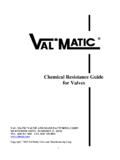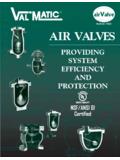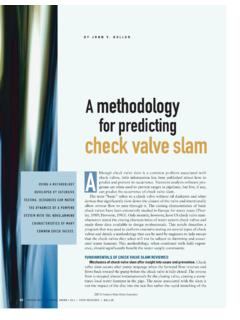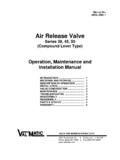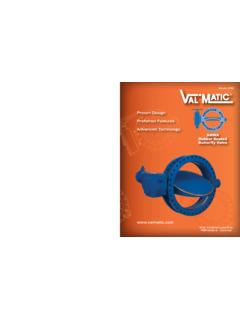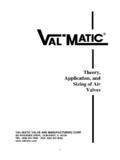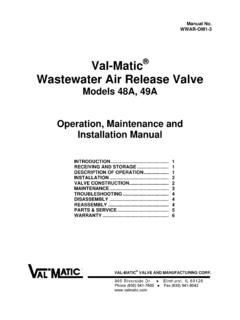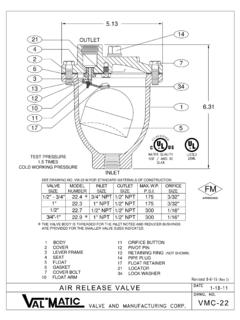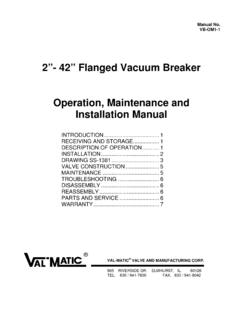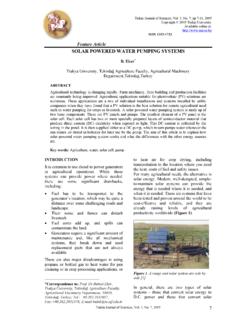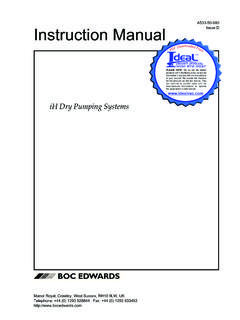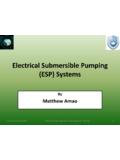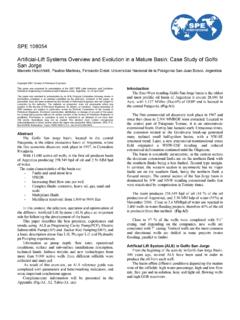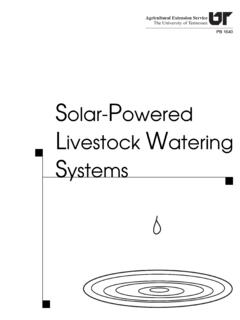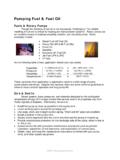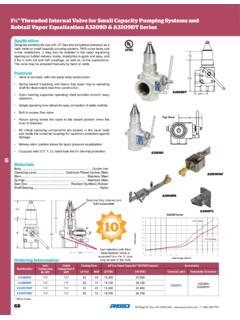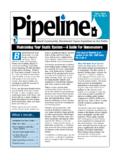Transcription of Surge Control in Pumping Systems - Val-Matic Valve & Mfg
1 Surge Control in Pumping Systems Val-Matic Valve AND MANUFACTURING CORP. 905 RIVERSIDE DRIVE, ELMHURST, IL 60126 TEL. (630) 941-7600 FAX. (630) 941-8042 Copyright 2009 Val-Matic Valve and Manufacturing Corp. 1 FOREWORD Surge Control in Pumping Systems was written to assist design engineers in understanding basic Surge Control principles and the functions of various valves associated with Pumping Systems . It is not intended to provide all of the information necessary for selecting valves but rather to explain in engineering terms the functions of check, air, and Control valves and their inherent flow and Surge characteristics.
2 Successful Pumping system design should consider the combined characteristics of the pump, check Valve , air Valve , Control Valve , and Surge equipment. With this knowledge, the design engineer can better select valves and understand some of the pitfalls common to Pumping system design. When selecting valves their flow characteristics are important, but other design issues such as head loss, reliability, and cost are equally important factors that should be considered in making the final Valve selections. The test data presented offers valuable information for predicting Valve performance.
3 It is based on independent tests conducted at the Utah Water Research Laboratory and remains the property of Val-Matic Valve & Mfg. Corp. Any use of this information in other public disclosures requires written permission from Val-Matic . Val-Matic offers no warranty or representation as to design information and methodologies in this paper. Use of this paper should be made under the direction of trained engineers exercising independent judgment regarding the suggested use of the valves in fluid Systems . Surge Control IN Pumping Systems INTRODUCTION Water pipelines and distribution Systems are subjected to surges almost daily, which over time can cause damage to equipment and possible contamination.
4 Surges are caused by sudden changes in fluid velocity and can be as minor as a few psi to five times the static pressure. The causes and effects of these surges in Pumping Systems will be discussed along with equipment designed to prevent and dissipate surges. Only with the knowledge of all of the associated valves and Surge equipment can a successful Pumping system with acceptable Surge levels be designed. Reference will be made to typical installations and examples so that an understanding of the applicable constraints can be gained. Figure 1 illustrates a typical water Pumping /distribution system where two parallel pumps draw water from a wet well then pump the water through check and butterfly valves into a pump header and distribution system .
5 A Surge tank and Surge relief Valve are shown as possible equipment on the pump header to relieve and prevent surges. Each of these will be discussed in greater detail. Figure 1. Typical Pumping /Distribution system 2 3 CAUSES AND EFFECTS Surges are caused by sudden changes in flow velocity that result from common causes such as rapid Valve closure, pump starts and stops, and improper filling practices. Pipelines often see their first Surge during filling when the air being expelled from a pipeline rapidly escapes through a manual vent or a throttled Valve followed by the water.
6 Being many times denser than air, water follows the air to the outlet at a high velocity but is then rapidly restricted by the outlet causing a Surge . It is imperative that the system fill flow rate be carefully controlled to less than 2 ft/sec fluid velocity and the air vented through properly sized automatic air valves. Similarly, line valves must be closed and opened slowly to prevent rapid changes in flow velocity. The operation of pumps and sudden stoppage of pumps due to power failures probably have the most frequent impact on the system and the greatest potential to cause significant and frequent surges.
7 If the Pumping system is not controlled or protected, contamination and damage to equipment and the pipeline itself can be serious. The effects of surges can be as minor as loosening of pipe joints to as severe as damage to pumps, valves, and concrete structures. Damaged pipe joints and vacuum conditions can cause contamination to the system from ground water and backflow situations. Uncontrolled surges can be catastrophic as well. Line breaks can cause flooding and line shifting can cause damage to supports and even concrete piers and vaults. Losses can be in the millions of dollars so it is essential that surges be understood and controlled with the proper equipment.
8 Surge BACKGROUND Some of the basic equations of Surge theory will be presented so that an understanding of Surge Control equipment can be gained. First, the Surge pressure (H) resulting from an instantaneous flow stoppage is directly proportional to the change in velocity and can be calculated as follows: H = a v / g where: H = Surge pressure, ft water column a = speed of pressure wave, ft/sec v = change in flow velocity, ft/sec g = gravity, ft/sec2 The speed of the pressure wave (a) varies with the fluid, pipe size, and pipe material.
9 For a medium sized steel line, it has a value of about 3500 ft/sec. For PVC pipes, the speed will be significantly less. For a 12 in. steel line with water flowing at 6 ft/sec, the magnitude of a Surge from an instantaneous flow stoppage is: H = (3500 ft/sec)(6 ft/sec) / (32 ft/sec2) H = 656 ft water column This Surge pressure of 656 feet (285 psi) is additive to the static line pressure; therefore, the 4resultant pressure will likely exceed the pressure rating of the system . Further, the Surge pressure will be maintained for several seconds as the wave reflects from one end of the piping system to the other end causing over pressurization of pipe seals, and fittings.
10 Then after a reflection, the pressure wave may cause a negative pressure and vacuum pockets for several seconds allowing contaminated ground water to be drawn into the system through seals or connections. Even higher velocities than the Pumping velocity are attainable in long piping Systems , especially when there are significant changes in grade. If the pumps are suddenly stopped due to a power failure, the kinetic energy of the water combined with the low inertia of the pump may cause a separation in the water column at the pump or at a highpoint in the pipeline. When the columns of water return via the static head of the line, the reverse velocity can exceed the normal velocity.
